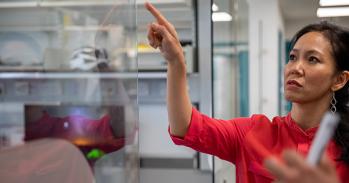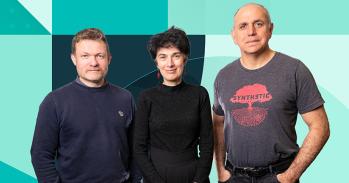
Launched today (26 September), Cancer Core Europe brings together six cancer centres – including the Cambridge Cancer Centre at the University of Cambridge – to link cancer research through to cancer care.
Launched today (26 September), Cancer Core Europe brings together six cancer centres – including the Cambridge Cancer Centre at the University of Cambridge – to link cancer research through to cancer care.
Our understanding of cancer is increasing faster than ever before, and over the next decade or so I believe that this will lead to a revolution in how physicians treat patients. This network will lead that revolution.
Patrick Maxwell
The consortium of European cancer centres will link cancer programmes on a huge scale to help the joint monitoring of patients and the development of next-generation clinical trials.
Cancer Core Europe, launched today, brings together the Cambridge Cancer Centre, the Gustave Roussy Cancer Campus Grand Paris (Villejuif, France), the Karolinska Institutet (Stockholm, Sweden), the Netherlands Cancer Institute (Amsterdam, The Netherlands), the Vall d’Hebron Institute of Oncology (Barcelona, Spain), and the German Cancer Research Center and its National Center for Tumor Diseases (Heidelberg, Germany).
Professor Carlos Caldas, from the University of Cambridge’s Department of Oncology and Cancer Research UK Cambridge Institute, has played a leading role in establishing the new collaboration. Cancer is a strategic research initiative within the University, and with around 150 research group leaders and 100 clinicians currently undertaking basic, translational or clinical cancer research, Cambridge has substantial expertise to offer the consortium.
Across the Cancer Core Europe consortium as a whole, ever year around 60,000 newly diagnosed cancer patients are seen, 300,000 cancer treatments are delivered, about 1,000,000 outpatient visits are performed, and around 1,500 clinical trials are conducted.
The consortium’s goal of linking scientific discovery from bench to bedside includes the creation of a virtual ‘e-hospital’ to enable joint research programs. Four areas of data will be linked across the partnership: electronic medical records that will ease the exchange of patient information according to clinical trial protocols; molecular imaging and diagnostics to enable comparable monitoring of patients; a clinical trial infrastructure that will eventually allow one of the six centres to sponsor trials across the consortium; and the development of innovative next generation clinical trials.
“This initiative brings together outstanding cancer centres across Europe in a visionary way,” said Patrick Maxwell, Regius Professor of Physic and Head of the School of Clinical Medicine. “Our understanding of cancer is increasing faster than ever before, and over the next decade or so I believe that this will lead to a revolution in how physicians treat patients. This network will lead that revolution.”
Cancer Core Europe will be able to support the full spectrum of research required to address the continuum between cancer research and cancer care, as well as provide a unique environment to train the next generation of talents in innovative translational and clinical oncology.
“There is little doubt that this partnership will bring new insights into, and opportunities to address, the critical issues we all face in caring for patients with cancer, and we are absolutely delighted, and incredibly excited to be part of it,” said Dr Keith McNeil, Chief Executive of Cambridge University Hospitals.
Susan Galbraith, Head of Oncology at Astra Zeneca, added: “The development of Cancer Core Europe is exciting. The understanding of the science that drives cancer growth is leading to rapid and significant changes in how we need to approach the diagnosis, monitoring and treatment of patients with cancer. If we are to be successful in bringing revolutionary new treatment regimens to patients quickly it will require this kind of collaboration across cancer centres. AZ Oncology looks forward to also collaborating with Cancer Core Europe to help deliver this revolutionary vision.”
Examples of the expertise that Cambridge brings to the Cancer Core Europe partnership
• An established and growing early phase clinical trials team already collaborating on innovative national and international clinical trials. The POSEIDON trial , co-led by Cambridge in collaboration with the Netherlands Cancer Institute and the Vall d'Hebron Cancer Centre in Barcelona, is assessing the effectiveness of combining Tamoxifen and the Genentech inhibitor GDC0032 in patients with ER+ breast cancer. The BET inhibitor trial is a phase I/II open-label, dose escalation study to investigate the safety, pharmacokinetics, pharmacodynamics and clinical activity of a BET-family inhibitor (GSK525762) in patients with relapsed, refractory haematologic malignancies.
• Pioneering development of the technology to analyse circulating tumour DNA. This technique has exciting potential application in the form of a ‘liquid biopsy’ from a simple blood sample that could be used in future for the early diagnosis of cancer and for monitoring how a tumour is responding to treatment.
• Novel magnetic resonance imaging methods, such as hyperpolarised C13 MRI, are being developed to detect how tumours are responding to treatment within hours rather than days, which will in future enable patients to be given the best personalised treatment for their cancer as soon as possible.
• The Joint Clinical Information System (JCIS) records key cancer data items and tracks treatment pathways for all patients with cancer at Addenbrooke’s Hospital and the use of electronic health records such as EPIC, recently launched at Addenbrooke’s, will enhance the ability to treat and monitor patients.
• The MRC Biostatistics Unit in Cambridge is one of the largest groups of biostatisticians in Europe and has established itself as an internationally acclaimed centre for research in biostatistics and a major centre for training and knowledge transfer. A particular area of expertise is the design and analysis of randomised trials, specifically to give them the flexibility to adapt as trial data emerges and to be used to plan the extent and scope of the next phase of research.
The text in this work is licensed under a Creative Commons Licence. If you use this content on your site please link back to this page. For image rights, please see the credits associated with each individual image.





